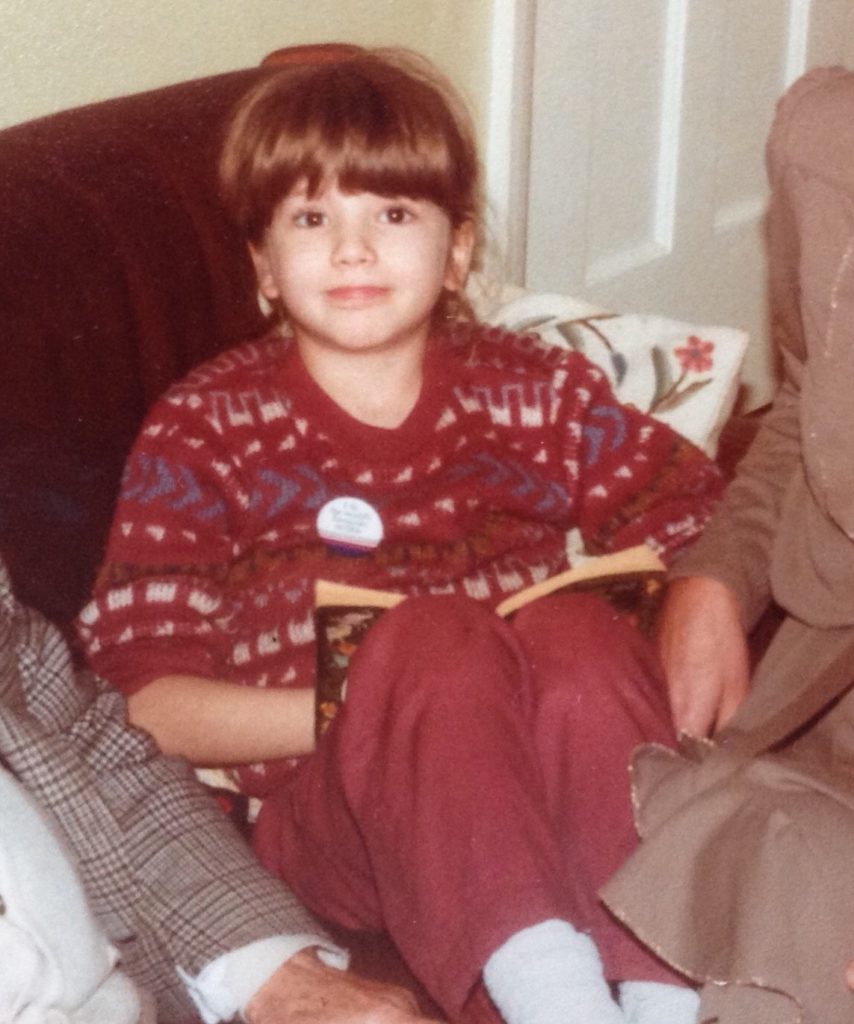In the run-up to the release of her debut children’s book ‘By Ash, Oak and Thorn’, Melissa Harrison gives some insight into its writing.

Melissa Harrison circa 1982
When I was seven or eight I had a pair of brown trousers. It was the early 80s but they dated from the 70s as most of my clothes did: I was the youngest of six and none of us had much that was new. My brown trousers were nylon or some other kind of artificial fabric, with an elasticated waist: they didn’t show the dirt (much), you could keep interesting things in the pockets, and they didn’t tear at the knee when you fell over or got them caught on rough bark ascending a tree. I pulled them on without thinking every day I didn’t have to put on a uniform, wore them until they were tight on the waist and too short even for my short legs. I loved them because they gave me freedom: freedom to play outside all day and not worry about spoiling them, and also freedom from having to choose an outfit or think about how I looked.
It’s only now – literally now, as I type – that it occurs to me they might have been boys’ trousers, perhaps once worn by my brother, eight years older than me. Quite possibly: it doesn’t matter now, and it wouldn’t have mattered then. I didn’t yet care what other people might think of me, only that they enabled me to be the kind of child I was: one who quite often had a toad about her person, had perpetually dirty hands and couldn’t come inside just yet because she was in the middle of an Important Quest. But as I approached what we now call the ‘pre-teen’ years and the trousers got shorter and shabbier, I remember very clearly the sense of wanting to hang on to them forever and not let them be taken away. I knew that something was coming that I wouldn’t be good at and didn’t want: I was going to have to become a girl.
The fact that I didn’t already feel like a girl doesn’t mean I thought that I was a boy, or wanted to be a boy, or that I’m not glad to be a woman now. It simply meant that I felt like a child, one granted – more by accident than design – the underrated privilege of rarely having to perform or inhabit any gender at all for a few precious, early years. Many of the children I knew back then seemed to inhabit the same freedom, though not all. I think it’s much harder, and rarer, to give that to a child today.
In 2019, working in secret, I sat down to begin writing a modern version of one of my most adored children’s books, B.B.’s Carnegie-winning 1942 classic The Little Grey Men. I knew that the first thing I’d need to update was the fact that all the main characters in the original books – Dodder and Sneezewort, Cloudberry and Baldmoney – were male. For weeks I tried creating female members of what I had begun to call the Hidden Folk (from the Icelandic and Faroese Huldufólk: ancient nature guardians) only for them all to fall flat somehow; I was haunted by the half-baked tokenism of the Little Miss books, Smurfette and The Wombles’ Madame Cholet. Obviously, I told myself, the fact that female versions of male children’s book characters had been badly served in the past didn’t mean it couldn’t be done well – unless, an unsettling inner voice whispered, it was my own internalised misogyny stopping me from bringing them to life? Frustrated and stuck, in my notebook I scribbled “ffs why do they have to be male or female AT ALL????”
Which is when I realised that, of course, they didn’t. If my Hidden Folk were immortal they had no need to reproduce, which meant there was no need in my story for biological sex. They could just be, and in doing so offer that precious possibility to young readers, too – if only I could find a way to make it work grammatically. That took me a while, but I hope and believe that I did.
So far, if asked, early readers of By Ash, Oak and Thorn have tended to code my characters male – no surprise at all, given that it remains humankind’s unconscious default. Some children have asked me which are ‘really’ boys and ‘really’ girls, or have guessed, based on aspects of their characters and it’s been interesting to see how deep that binary runs, as well as the imaginative possibilities that open up when it’s disrupted.
A few, though, don’t seem even to have considered the question but have simply delighted in the magical Wild World I’ve presented to them, one that I hope is as rich in natural and seasonal detail as B.B.’s classic but which takes in the city as well as the countryside, and in which the four friends Moss, Cumulus, Burnet and Sorrel play outdoors all day, climb trees, go on Important Quests and make the animals their friends.
*
‘By Ash, Oak and Thorn’ is published by Chicken House on 4 May. Pre-order a copy here. Its sequel, ‘By Rowan and Yew’, is due out in October.